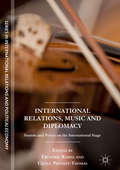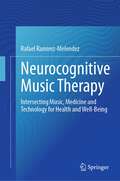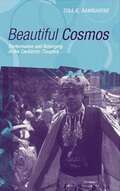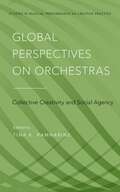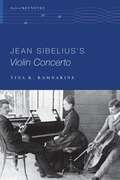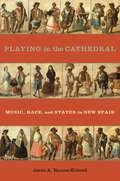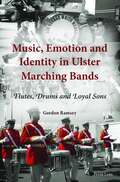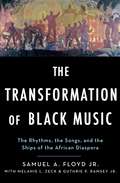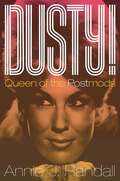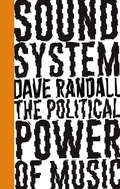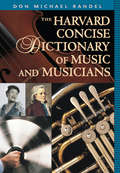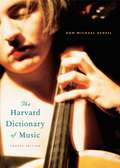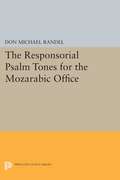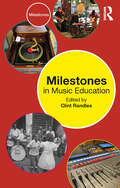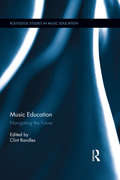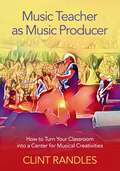- Table View
- List View
International Relations, Music and Diplomacy: Sounds and Voices on the International Stage (The Sciences Po Series in International Relations and Political Economy)
by Frédéric Ramel Cécile Prévost-ThomasThis volume explores the interrelation of international relations, music, and diplomacy from a multidisciplinary perspective. Throughout history, diplomats have gathered for musical events, and musicians have served as national representatives. Whatever political unit is under consideration (city-states, empires, nation-states), music has proven to be a component of diplomacy, its ceremonies, and its strategies. Following the recent acoustic turn in IR theory, the authors explore the notion of “musical diplomacies” and ask whether and how it differs from other types of cultural diplomacy. Accordingly, sounds and voices are dealt with in acoustic terms but are not restricted to music per se, also taking into consideration the voices (speech) of musicians in the international arena.Read an interview with the editors here: https://www.sciencespo.fr/ceri/en/content/international-relations-music-and-diplomacy-sounds-and-voices-international-stage
International Relations, Music and Diplomacy: Sounds and Voices on the International Stage (The Sciences Po Series in International Relations and Political Economy)
by Frédéric Ramel Cécile Prévost-ThomasThis volume explores the interrelation of international relations, music, and diplomacy from a multidisciplinary perspective. Throughout history, diplomats have gathered for musical events, and musicians have served as national representatives. Whatever political unit is under consideration (city-states, empires, nation-states), music has proven to be a component of diplomacy, its ceremonies, and its strategies. Following the recent acoustic turn in IR theory, the authors explore the notion of “musical diplomacies” and ask whether and how it differs from other types of cultural diplomacy. Accordingly, sounds and voices are dealt with in acoustic terms but are not restricted to music per se, also taking into consideration the voices (speech) of musicians in the international arena.Read an interview with the editors here: https://www.sciencespo.fr/ceri/en/content/international-relations-music-and-diplomacy-sounds-and-voices-international-stage
Neurocognitive Music Therapy: Intersecting Music, Medicine and Technology for Health and Well-Being
by Rafael Ramírez-MeléndezFor thousands of years, music has acted as a powerful medium for evoking emotions, facilitating communication, and nurturing overall well-being. With the advent of new sophisticated neuroimaging technology, human responses to music and music therapy are being viewed through a new lens. As a consequence, new knowledge is being obtained about how music can produce significant improvements in cognitive, social, overt and agitated behaviours. The aim of this book is to provide an overview of neurocognitive music therapy, its impact and implications in the practice of evidence-based music interventions. The book seeks to provide researchers, psychologists, music therapists, musicians and physicians interested in the therapeutic applications of music, with a source of information about current techniques and novel music interventions. It is structured into several chapters, each of them presenting peer-reviewed research and evidence-based procedures carried out in a specific clinical context. Topics covered in the book include: Musical engagement for individuals with motor disabilities Enhancing emotional processing in autism through music Stroke rehabilitation via musical interventions Musical neurofeedback for emotional disorders Emotional modulation with music therapy in palliative care AI-driven personalisation in music interventionsThe book highlights the profound capacity of music-based interventions to facilitate cognitive and emotional processing, enhance communication, and promote motor rehabilitation. At the same time, the book demonstrates how modern technologies offer new opportunities to evaluate, validate, and potentiate music-based interventions, allowing new and innovative possibilities and more personalised interventions. This book aims to contribute to the growing body of knowledge in this field and inspire further research and innovation in the practice of music therapy.
Beautiful Cosmos (PDF): Performance And Belonging In The Caribbean Diaspora
by Tina K. RamnarineWhat are the musical sounds that people remember in the diaspora? What are the sounds they create? Recognising the importance that people attach to musical performances, this book explores the significance of widespread Caribbean genres in diaspora politics.
Global Perspectives on Orchestras: Collective Creativity and Social Agency (Studies in Musical Perf as Creative Prac)
by Tina K. RamnarineOffering innovative approaches to thinking about orchestras, Global Perspectives on Orchestras: Collective Creativity and Social Agency adopts ethnographic, historical and comparative perspectives on a variety of traditions, including symphony, Caribbean steel, Indonesian gamelan, Indian film and Vietnamese court examples. The volume presents compelling analyses of orchestras in their socio-historical, economic, intercultural and postcolonial contexts, while emphasizing the global and historical connections between musical traditions. By drawing on new ethnographic and historical data, the essays describe orchestral creative processes and the politics shaping performance practices. Each essay considers how musicians work together in ensembles, focusing on issues such as training, rehearsal, creative choices, compositional processes, and organizational infrastructures. Testimonies of orchestral musicians highlight practitioners' views into the diverse world of orchestras. As a whole, the volume discusses the creative roles of performers, arrangers, composers and arts agencies, as well as the social environments supporting musical collaborations. With contributions from an international team of researchers, Global Perspectives on Orchestras offers critical insights gained from the study of orchestras, collective creativity and social agency, and the connections between orchestral performances, colonial histories, postcolonial practices, ethnographic writings and comparative theorizations.
Ilmatar's Inspirations: Nationalism, Globalization, and the Changing Soundscapes of Finnish Folk Music (Chicago Studies in Ethnomusicology)
by Tina K. RamnarineIlmatar gave birth to the bard who sang the Finnish landscape into being in the Kalevala (the Finnish national epic). In Ilmatar's Inspirations, Tina K. Ramnarine explores creative processes and the critical role that music has played in Finnish nationalism by focusing on Finnish "new folk music" in the shifting spaces between the national imagination and the global marketplace. Through extensive interviews and observations of performances, Ramnarine reveals how new folk musicians think and talk about past and present folk music practices, the role of folk music in the representation of national identity, and the interactions of Finnish folk musicians with performers from around the globe. She focuses especially on two internationally successful groups—JPP, a group that plays fiddle dance music, and Värttinä, an ensemble that highlights women's vocal traditions. Analyzing the multilayered processes—musical, institutional, political, and commercial—that have shaped and are shaped by new folk music in Finland, Ramnarine gives us an entirely new understanding of the connections between music, place, and identity.
Jean Sibelius's Violin Concerto (The Oxford Keynotes Series)
by Tina K. RamnarineJean Sibelius's Violin Concerto is the story of Sibelius as performer and composer, of violin performing traditions, of histories of musical transmission, and of virtuosity itself. It investigates the history and legacy of one of the most recorded concertos in the violin repertoire. Sibelius, a celebrated and influential composer of the late 19th and 20th centuries, was an accomplished violinist, whose enduring interest in the instrument has been paralleled by the broad success of the only concerto in his oeuvre: his violin concerto (premiered in 1904 and revised in 1905). Considering how violinists engage with the work, author Tina K. Ramnarine discusses technology's central role in the concerto's transmission from Jascha Heifetz's seminal 1935 recording to contemporary online performances, gender issues in violin solo careers, and nature-based musical aesthetics that lead to thinking about the ecology of virtuosity in an era of environmental crisis. Beginning with Sibelius's early training as a violinist and his aspirations as a performer, Ramnarine traces the dramatic historical context of the violin concerto. It was composed as Finland underwent a period of heightened self-determination, nationalism, and protest against Russian imperial policies, and it heralded intense political dynamics relating to Europe's East-West border that have extended to the present. This story of the violin concerto points to the notion of Sibelius - and the virtuoso more generally - as a political figure.
JEAN SIBELIUSS VIOLIN CONCERTO C (The Oxford Keynotes Series)
by Tina K. RamnarineJean Sibelius's Violin Concerto is the story of Sibelius as performer and composer, of violin performing traditions, of histories of musical transmission, and of virtuosity itself. It investigates the history and legacy of one of the most recorded concertos in the violin repertoire. Sibelius, a celebrated and influential composer of the late 19th and 20th centuries, was an accomplished violinist, whose enduring interest in the instrument has been paralleled by the broad success of the only concerto in his oeuvre: his violin concerto (premiered in 1904 and revised in 1905). Considering how violinists engage with the work, author Tina K. Ramnarine discusses technology's central role in the concerto's transmission from Jascha Heifetz's seminal 1935 recording to contemporary online performances, gender issues in violin solo careers, and nature-based musical aesthetics that lead to thinking about the ecology of virtuosity in an era of environmental crisis. Beginning with Sibelius's early training as a violinist and his aspirations as a performer, Ramnarine traces the dramatic historical context of the violin concerto. It was composed as Finland underwent a period of heightened self-determination, nationalism, and protest against Russian imperial policies, and it heralded intense political dynamics relating to Europe's East-West border that have extended to the present. This story of the violin concerto points to the notion of Sibelius - and the virtuoso more generally - as a political figure.
Playing in the Cathedral: Music, Race, and Status in New Spain (Currents in Latin American and Iberian Music)
by Jesús A. Ramos-KittrellThroughout Spanish colonial America, limpieza de sangre (literally, "purity of blood") determined an individual's status within the complex system of social hierarchy called casta. Within this socially stratified culture, those individuals at the top were considered to have the highest calidad-an all-encompassing estimation of a person's social status. At the top of the social pyramid were the Peninsulares: Spaniards born in Spain, who controlled most of the positions of power within the colonial governments and institutions. Making up most of the middle-class were criollos, locally born people of Spanish ancestry. During the late seventeenth and early eighteenth centuries, Peninsulare intellectuals asserted their cultural superiority over criollos by claiming that American Spaniards had a generally lower calidad because of their "impure" racial lineage. Still, given their Spanish heritage, criollos were allowed employment at many Spanish institutions in New Spain, including the center of Spanish religious practice in colonial America: Mexico City Cathedral. Indeed, most of the cathedral employees-in particular, musicians-were middle-class criollos. In Playing in the Cathedral, author Jesús Ramos-Kittrell explores how liturgical musicians-choristers and instrumentalists, as well as teachers and directors-at Mexico City Cathedral in the mid-eighteenth century navigated changing discourses about social status and racial purity. He argues that criollos cathedral musicians, influenced by Enlightenment values of self-industry and autonomy, fought against the Peninsulare-dominated, racialized casta system. Drawing on extensive archival research, Ramos-Kittrell shows that these musicians held up their musical training and knowledge, as well as their institutional affiliation with the cathedral, as characteristics that legitimized their calidad and aided their social advancement. The cathedral musicians invoked claims of "decency" and erudition in asserting their social worth, arguing that their performance capabilities and theoretical knowledge of counterpoint bespoke their calidad and status as hombres decentes. Ultimately, Ramos-Kittrell argues that music, as a performative and theoretical activity, was a highly dynamic factor in the cultural and religious life of New Spain, and an active agent in the changing discourses of social status and "Spanishness" in colonial America. Offering unique and fascinating insights into the social, institutional, and artistic spheres in New Spain, this book is a welcome addition to scholars and graduate students with particular interests in Latin American colonial music and cultural history, as well as those interested in the intersections of music and religion.
Playing in the Cathedral: Music, Race, and Status in New Spain (Currents in Latin American and Iberian Music)
by Jesús A. Ramos-KittrellThroughout Spanish colonial America, limpieza de sangre (literally, "purity of blood") determined an individual's status within the complex system of social hierarchy called casta. Within this socially stratified culture, those individuals at the top were considered to have the highest calidad-an all-encompassing estimation of a person's social status. At the top of the social pyramid were the Peninsulares: Spaniards born in Spain, who controlled most of the positions of power within the colonial governments and institutions. Making up most of the middle-class were criollos, locally born people of Spanish ancestry. During the late seventeenth and early eighteenth centuries, Peninsulare intellectuals asserted their cultural superiority over criollos by claiming that American Spaniards had a generally lower calidad because of their "impure" racial lineage. Still, given their Spanish heritage, criollos were allowed employment at many Spanish institutions in New Spain, including the center of Spanish religious practice in colonial America: Mexico City Cathedral. Indeed, most of the cathedral employees-in particular, musicians-were middle-class criollos. In Playing in the Cathedral, author Jesús Ramos-Kittrell explores how liturgical musicians-choristers and instrumentalists, as well as teachers and directors-at Mexico City Cathedral in the mid-eighteenth century navigated changing discourses about social status and racial purity. He argues that criollos cathedral musicians, influenced by Enlightenment values of self-industry and autonomy, fought against the Peninsulare-dominated, racialized casta system. Drawing on extensive archival research, Ramos-Kittrell shows that these musicians held up their musical training and knowledge, as well as their institutional affiliation with the cathedral, as characteristics that legitimized their calidad and aided their social advancement. The cathedral musicians invoked claims of "decency" and erudition in asserting their social worth, arguing that their performance capabilities and theoretical knowledge of counterpoint bespoke their calidad and status as hombres decentes. Ultimately, Ramos-Kittrell argues that music, as a performative and theoretical activity, was a highly dynamic factor in the cultural and religious life of New Spain, and an active agent in the changing discourses of social status and "Spanishness" in colonial America. Offering unique and fascinating insights into the social, institutional, and artistic spheres in New Spain, this book is a welcome addition to scholars and graduate students with particular interests in Latin American colonial music and cultural history, as well as those interested in the intersections of music and religion.
Music, Emotion And Identity In Ulster Marching Bands: Flutes, Drums And Loyal Sons (pdf)
by Gordon RamseyUlster's marching bands form perhaps the most vibrant participatory folk music tradition in contemporary Europe, and are one of the most significant and visible elements of working-class loyalist culture in the divided society of Northern Ireland. Their significance springs largely from the central place they have assumed in the lives of their members. This book presents an ethnography of three County Antrim flute bands from the very different genres of 'part-music', 'melody' and 'blood and thunder'. The author explores the emotional rewards of communal music-making and the way that identities are formed through the acquisition of tastes, competences and skills within specific communal contexts, paying particular attention to the impact of class position. These issues are examined in the context of the competitions, concerts and street parades that are central to the social lives of thousands of band members and supporters in Northern Ireland.
Music, Emotion and Identity In Ulster Marching Bands (PDF): Flutes, Drums And Loyal Sons
by Gordon RamseyUlster's marching bands form perhaps the most vibrant participatory folk music tradition in contemporary Europe, and are one of the most significant and visible elements of working-class loyalist culture in the divided society of Northern Ireland. Their significance springs largely from the central place they have assumed in the lives of their members. This book presents an ethnography of three County Antrim flute bands from the very different genres of 'part-music', 'melody' and 'blood and thunder'. The author explores the emotional rewards of communal music-making and the way that identities are formed through the acquisition of tastes, competences and skills within specific communal contexts, paying particular attention to the impact of class position. These issues are examined in the context of the competitions, concerts and street parades that are central to the social lives of thousands of band members and supporters in Northern Ireland.
The Transformation of Black Music: The rhythms, the songs, and the ships of the African Diaspora
by Guthrie Ramsey Sam Floyd Melanie ZeckPowerful and embracive, The Transformation of Black Music explores the full spectrum of black musics over the past thousand years as Africans and their descendants have traveled around the globe making celebrated music both in their homelands and throughout the Diaspora. Authors Samuel A. Floyd, Melanie Zeck, and Guthrie Ramsey brilliantly discuss how the music has blossomed, permeated present traditions, and created new practices. As a companion to the ground-breaking The Power of Black Music, this text brilliantly situates emerging, morphing, and influential black musics in a broader framework of cultural, political, and social histories. Grappling with subjects frequently omitted from traditional musical texts, The Transformation of Black Music is guided by more than just the ideals of inclusivity and representation. This work covers overlooked topics that include classical musicians of African descent, and builds upon the contributions of esteemed predecessors in the field of black music study. Providing a sweeping list of figures rarely included in conventional music history and theory textbooks, the text elucidates the findings of ethnomusicologists, cultural historians, Americanists, Africanists, and anthropologists, and weaves these accounts into a powerful and informative narrative. Taking its readers on a journey - one that has never been attempted in a single volume alone - this book reflects the musical phenomena generated by forced African migration and collective memory, and considers the kinds of powerful stories that these musics were meant to tell. Filling in critical musical and historical gaps previously ignored, authors Floyd, Zeck, and Ramsey infuse an engaging musical dialogue with a deeper understanding of the interrelationships between black musical genres and mainstream music. The Transformation of Black Music will solidify not only the inestimable value of black musics, but also the importance and relevance of black music research to all musical endeavors.
Dusty!: Queen of the Postmods
by Annie J. RandallDubbed the "White Queen of Soul," singer Dusty Springfield became the first British soloist to break into the U.S. Top Ten music charts with her 1964 hit "I Only Want To Be With You"--a pop classic followed by many others, including "You Don't Have to Say You Love Me" and "Son of a Preacher Man." Today she is usually placed within the history of the Beatles-led "British Invasion" or seen as a devoted acolyte of Motown. In this penetrating look at her music and career, Annie J. Randall shows how Springfield's contributions transcend the narrow limits of those descriptions and how this middle-class former convent girl became perhaps the unlikeliest of artists to achieve soul credibility on both sides of the Atlantic. Randall reevaluates Springfield's place in sixties popular music through close investigation of her performances as well as interviews with her friends, peers, professional associates, and longtime fans. As the author notes, the singer's unique look--blonde beehive wigs and heavy black mascara--became iconic of the mid-sixties postmodern moment in which identity scrambling and camp pastiche were the norms in swinging London's pop culture. Randall places Springfield within this rich cultural context, focusing on the years from 1964 to 1968, when she recorded her biggest international hits and was a constant presence on British television. The book pays special attention to Springfield's close collaboration and friendship with American gospel singer Madeline Bell, the distinctive way Springfield combined US soul and European melodrama to achieve her own musical style and stage presence, and how her camp sensibility figured as a key element of her artistry.
Dusty!: Queen of the Postmods
by Annie J. RandallDubbed the "White Queen of Soul," singer Dusty Springfield became the first British soloist to break into the U.S. Top Ten music charts with her 1964 hit "I Only Want To Be With You"--a pop classic followed by many others, including "You Don't Have to Say You Love Me" and "Son of a Preacher Man." Today she is usually placed within the history of the Beatles-led "British Invasion" or seen as a devoted acolyte of Motown. In this penetrating look at her music and career, Annie J. Randall shows how Springfield's contributions transcend the narrow limits of those descriptions and how this middle-class former convent girl became perhaps the unlikeliest of artists to achieve soul credibility on both sides of the Atlantic. Randall reevaluates Springfield's place in sixties popular music through close investigation of her performances as well as interviews with her friends, peers, professional associates, and longtime fans. As the author notes, the singer's unique look--blonde beehive wigs and heavy black mascara--became iconic of the mid-sixties postmodern moment in which identity scrambling and camp pastiche were the norms in swinging London's pop culture. Randall places Springfield within this rich cultural context, focusing on the years from 1964 to 1968, when she recorded her biggest international hits and was a constant presence on British television. The book pays special attention to Springfield's close collaboration and friendship with American gospel singer Madeline Bell, the distinctive way Springfield combined US soul and European melodrama to achieve her own musical style and stage presence, and how her camp sensibility figured as a key element of her artistry.
Sound System: The Political Power of Music (Left Book Club)
by Dave RandallMusicians have often wanted to change the world. From underground innovators to pop icons many have believed in the political power of music. Rulers recognise it too. Music has been used to challenge the political and social order - and to prop up the status quo.*BR**BR*Sound System is the story of one musician's journey to discover what makes music so powerful. Dave Randall uses his insider's knowledge of the industry to shed light on the secrets of celebrity, commodification and culture.*BR**BR*This is a book of raves, riots and revolution. From the Glastonbury Festival to the Arab Spring, Pop Idol to Trinidadian Carnival, Randall finds political inspiration across the musical spectrum and poses the question: how can we make music serve the interests of the many, rather than the few? *BR**BR*Published in partnership with the Left Book Club.
Sound System: The Political Power of Music (Left Book Club)
by Dave RandallMusicians have often wanted to change the world. From underground innovators to pop icons many have believed in the political power of music. Rulers recognise it too. Music has been used to challenge the political and social order - and to prop up the status quo.*BR**BR*Sound System is the story of one musician's journey to discover what makes music so powerful. Dave Randall uses his insider's knowledge of the industry to shed light on the secrets of celebrity, commodification and culture.*BR**BR*This is a book of raves, riots and revolution. From the Glastonbury Festival to the Arab Spring, Pop Idol to Trinidadian Carnival, Randall finds political inspiration across the musical spectrum and poses the question: how can we make music serve the interests of the many, rather than the few? *BR**BR*Published in partnership with the Left Book Club.
The Harvard Concise Dictionary of Music and Musicians (Economics And Business Victorian Curriculum Ser. #17)
by Don Michael RandelThis new compact guide to the history and performance of music is both authoritative and a pleasure to use. With entries drawn and condensed from the widely acclaimed Harvard Dictionary of Music (now in its fourth edition) and its companion The Harvard Biographical Dictionary of Music, it is a dependable reference for home and classroom and for professional and amateur musicians. This concise dictionary offers definitions of musical terms; succinct characterizations of the various forms of musical composition; entries that identify individual operas, oratorios, symphonic poems, and other works; illustrated descriptions of instruments; and capsule summaries of the lives and careers of composers, performers, and theorists. Like its distinguished parent volumes, The Harvard Concise Dictionary of Music and Musicians provides information on all periods in music history, with particularly comprehensive coverage of the twentieth century. Clearly written and based on vast expertise, The Harvard Concise Dictionary of Music and Musicians is an invaluable handbook for everyone who cares about music.
The Harvard Dictionary of Music: Fourth Edition (Harvard University Press Reference Library #10)
by Don Michael RandelThis classic reference work, the best one-volume music dictionary available, has been brought completely up to date in this new edition. Combining authoritative scholarship and lucid, lively prose, the Fourth Edition of The Harvard Dictionary of Music is the essential guide for musicians, students, and everyone who appreciates music.
The Responsorial Psalm Tones for the Mozarabic Office
by Don Michael RandelThis definitive study takes as its subject a group of melodies copied many times, even within single manuscripts. Professor Randel is therefore able to base his conclusions about the relationship of the manuscript sources to one another on twenty-six separate Spanish manuscripts. He shows that there were actually four distinct traditions associated with these manuscripts instead of two as formerly assumed. By comparing the four traditions, he draws new conclusions about the relative antiquity of the written tradition for these psalm tones, the presence or absence of a modal system in the Mozarabic chant, and the development of the two general types of notation.Originally published in 1969.The Princeton Legacy Library uses the latest print-on-demand technology to again make available previously out-of-print books from the distinguished backlist of Princeton University Press. These editions preserve the original texts of these important books while presenting them in durable paperback and hardcover editions. The goal of the Princeton Legacy Library is to vastly increase access to the rich scholarly heritage found in the thousands of books published by Princeton University Press since its founding in 1905.
Milestones in Music Education (Milestones)
by Clint RandlesIn ten concise chapters, Milestones in Music Education introduces the key developments and issues that have shaped the field of music education. Designed for undergraduate students, each chapter of the book is written by a different expert, bringing together many leading voices in the field. The ten chosen milestones represent breakthroughs in the field of music education that are relevant to today’s educators, and enable teachers to understand the issues that have shaped the teaching of music over time. Topics covered include the origins of music education as a school subject, the impact of changing technology, the roles of popular music and notation, and racial justice in the music classroom. Featuring action suggestions and discussion questions in each chapter, this accessible book provides students with a foundation in the history and context of music education, and prepares them to engage with the social and philosophical aspects of teaching music as forward-thinking educators. Milestones are a range of accessible textbooks, breaking down the need-to-know moments in the social, cultural, political and artistic development of foundational subject areas. This book is ideal for undergraduate courses in music education.
Music Education: Navigating the Future (Routledge Studies in Music Education #1)
by Clint RandlesEducation involving music is a multifaceted and ever-altering challenge. As new media, technologies, and pedagogies are developed, academics and practitioners must make sure that they are aware of current trends and where they might lead. This book features studies on the future of music education from emerging scholars in the field. These studies are then supplemented by commentaries from established leaders of the music education community. Music Education covers topics such as music and leisure, new forms of media in music teaching and learning, the role of technology in music learning, popular music tuition in the expansion of curricular offering, and assessment of music education research. As such, it is an excellent reference for scholars and teachers as well as guide to the future of the discipline.
Music Education: Navigating the Future (Routledge Studies in Music Education)
by Clint RandlesEducation involving music is a multifaceted and ever-altering challenge. As new media, technologies, and pedagogies are developed, academics and practitioners must make sure that they are aware of current trends and where they might lead. This book features studies on the future of music education from emerging scholars in the field. These studies are then supplemented by commentaries from established leaders of the music education community. Music Education covers topics such as music and leisure, new forms of media in music teaching and learning, the role of technology in music learning, popular music tuition in the expansion of curricular offering, and assessment of music education research. As such, it is an excellent reference for scholars and teachers as well as guide to the future of the discipline.
Music Teacher as Music Producer: How to Turn Your Classroom into a Center for Musical Creativities
by Clint RandlesNever has there been such an exciting time to be a music teacher. Band, choir, and orchestra are ubiquitous in schools and have come to be known as the primary mode that students experience music at the secondary level. Similarly, elementary school classrooms feature approaches by Orff, Kodaly, Dalcroze, and Music Learning Theory, among a host of others. But, what is next? In this enlightening guide, author Clint A. Randles provides music educators with the practical tools to turn their classrooms into student production studios. Addressing everything from a new conceptualization of the physical classroom space to the cables and other audio equipment no music educator should be without, Randles puts creativity, technology, recording arts, songwriting, music production, and live performance at the center of music classrooms.
Music Teacher as Music Producer: How to Turn Your Classroom into a Center for Musical Creativities
by Clint RandlesNever has there been such an exciting time to be a music teacher. Band, choir, and orchestra are ubiquitous in schools and have come to be known as the primary mode that students experience music at the secondary level. Similarly, elementary school classrooms feature approaches by Orff, Kodaly, Dalcroze, and Music Learning Theory, among a host of others. But, what is next? In this enlightening guide, author Clint A. Randles provides music educators with the practical tools to turn their classrooms into student production studios. Addressing everything from a new conceptualization of the physical classroom space to the cables and other audio equipment no music educator should be without, Randles puts creativity, technology, recording arts, songwriting, music production, and live performance at the center of music classrooms.
